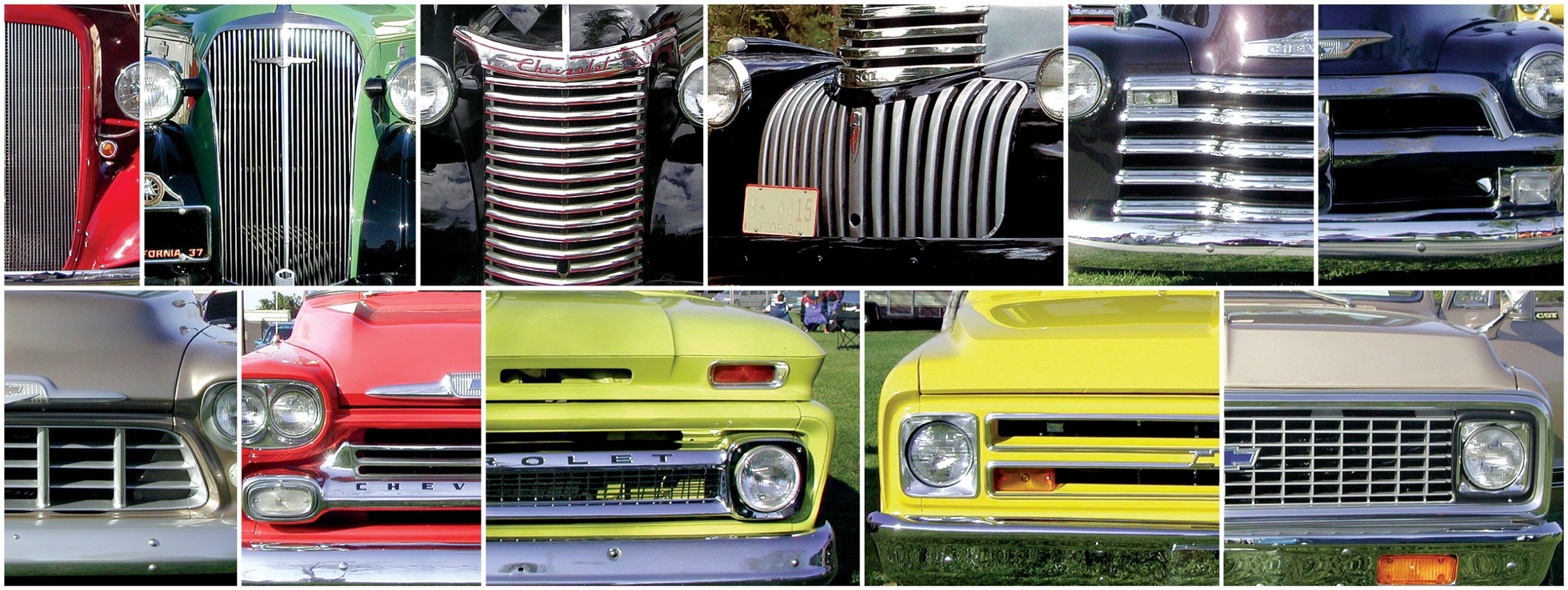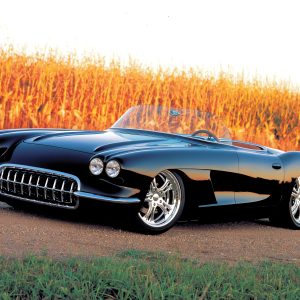A Holley Kit That Produces 441HP—and Eliminates the Guesswork
Like everything else in life, our quest for performance requires that we accept the good with the bad. Case in point: building or improving the performance of your small-block Chevy.

The good side of the equation is that the small block has been around since the mid-’50s and as such, has a tremendous following both in terms of enthusiasts and the performance industry. The benefit of the popularity is that there is an abundance of performance hardware available directly from Chevrolet in the form of its GMPP catalog, as well as from the aftermarket. The availability means that we have many choices when it comes time to build or upgrade our existing powerplants.

The downside to the abundance of aftermarket availability means that not only do we have enough choices, but often times we have too many. By this we mean that the vast array of different manufacturers and associated components can be nearly overwhelming. Which heads go with which cams, and why can’t someone go to the trouble of assembling the various accessory components that are required to duplicate advertised test results?

Well, fellow Chevy enthusiasts, it looks like Holley has heard this loud and clear, and responded with an inexpensive (given the power achieved) performance package designed to take the guesswork out of building a 400-plus horsepower small-block Chevy. The Holley SysteMAX engine kits are available for both small- and big-block Chevy motors, in power ranges from 350 hp for the small block to 560 hp for the big block.
Our focus is on PN 300-503-1, designed to produce over 400 hp using a carefully matched combination of intake, cam and cylinder heads. Not surprisingly, this power range offered by the two small-block SysteMAX kits covers the most popular power level used by street enthusiasts.

Sure, we all want to brag about having a 600-plus horsepower small block, but the reality is that short of forced induction, not many street small blocks can achieve that power level with any kind of streetability. Holley took this fact into account when designing these engine kits. For most of us, all we want (or need) is a good set of performance aluminum heads and matching cam to go with a four-barrel carb and dual-plane intake. Such a combination should produce gobs of horsepower and torque, combined with thousands and thousands of trouble-free miles.

Naturally, we wanted to put one of these kits to the test, so we immediately contacted Holley. The highlight of its performance kit was the set of SysteMAX aluminum cylinder heads. Right off the bat, the aluminum heads offered a performance gain (compared to a set of traditional cast-iron heads) by reducing the curb weight. Those few enthusiasts who still cling to the notion that cast-iron heads are somehow stronger or in some way superior to aluminum heads should join the rest of us here in reality. Aluminum heads offer nothing but advantages in weight, reduced detonation and repair ability, compared to the old-tech iron heads, to say nothing of the superior port and chamber designs that greatly improve power potential. Even the very best Fuelie, Camel back or Turbo heads are no match for a set of off-the-shelf, 20-degree Holley SysteMAX aluminum heads.

Cylinder head port design has come a long way since the introduction of the small block, even since the muscle-car era. It should come as no surprise that a head with a few decades of development can outperform a set of the early GM performance castings, to say nothing of a set of the more pedestrian variety.
Though Holley offered a SysteMAX kit consisting of a dual-plane intake and matching camshaft (lifters and timing chain), we went whole hog and opted for the maximum performance carbureted street kit. We liked the idea of having over 400 hp and 400 lb-ft of torque at our disposal. Helping us reach that power level was an impressive set of SysteMAX cylinder heads.

According to Holley literature, the 20-degree small-block heads flowed over 223 cfm on the intake and nearly 173 cfm on the exhaust. These flow figures were achieved using the supplied 2.02 and 1.60 stainless steel intake and exhaust valves. The SysteMAX heads featured a straight spark plug angle and 68cc combustion chambers. The intake ports measured 184 cc, while the exhaust ports checked in at 68 cc. Of course, it is possible to greatly improve the flow rate of the heads with additional porting, but we wanted to check out the results of the heads as delivered by Holley, since most customers will simply bolt them on. Additional features on the SysteMAX heads included three-angle valve job, bronze valve guides and Pro-E designed combustion chambers. Heavy-duty dual valve springs ensured plenty of spring pressure for our 425hp combination.

One of the keys to obtaining maximum performance from any combination is the camshaft. Lucky for us, Holley saw fit to choose a dyno-proven camshaft profile, which was designed to work with the high-flow aluminum cylinder heads and dual-plane intake manifold. Working in conjunction with the intake runner length, the cam profile helps determine the operating rpm range of the combination. Using the same Holley 20-degree aluminum heads and matching intake, it is possible to alter the power curve by selecting a different cam profile. Cam timing is where enthusiasts usually go astray. The wrong cam can literally ruin an otherwise good combination.
Lucky for us, Holley has tested this particular combination and as such, we know what to expect in terms of a power curve. The flow data on the Holley heads dictated a dual-pattern cam. The SysteMAX cam offered 0.490-inch lift (intake and exhaust), but a 235/240-duration split at 0.050 inch. The 112-degree lobe separation angle should help tame the cam somewhat by improving the idle vacuum and broadening the torque curve without sacrificing power.

The hydraulic flat-tappet cam was designed to fit directly in our early block. The cam provided the specified lift values working in conjunction with a set of 1.5:1-ratio roller rockers. Though not supplied with the kit, Holley recommended a set of Lunati (PN 84146) roller rockers for our test motor. Stock, stamped-steel rockers can be used if you are on a budget, but roller rockers will ensure accurate and consistent ratios to maximize the effectiveness of the cam profile.

The SysteMAX kit also included a matching dual-plane intake manifold. Holley’s Street Dominator (PN 300-36S) offered a high-rise design and a broad power range from idle to 7,200 rpm. Naturally, the intake was designed to run a Holley carb (the recommended version being a 750cfm double pumper), but a vacuum secondary could be made to work just as well with a little tuning. The dual-plane design ensured a broad power band and plenty of torque production in the most usable part of the rev range.
It is possible that more peak power could be had with a single-plane design, but low- and mid-range torque would suffer dearly with the installation of the racy intake. Though the highlights of the SysteMAX engine kit were indeed the impressive heads, cam and intake, the kit included many other smaller yet no less important components. Holley also saw fit to include a double-roller timing chain and lifters, ARP head bolts and hardened pushrods, and a container of assembly lube to ensure the cam had plenty of lubrication during that all-important initial break-in period.

To put the Holley engine kit to the test, we installed the complete system on a typical 350 Chevy short block. Our SBC test motor (supplied by Coast High Performance) featured a cast crank, forged rods and forged flattop pistons with valve reliefs. The block was of the more desirable four-bolt main variety, but that was an unnecessary luxury at this power level. The SysteMAX hydraulic flat-tappet cam and lifters were installed after properly lubing them with the supplied assembly lube.

Having already run wilder cam combinations on our test motor, it was not necessary to check piston-to-valve clearance, but it is always a good idea when installing a wilder cam in place of a stocker. Of course, we employed the double-roller timing chain on our motor after installing the performance cam. Using a Fel-Pro gasket set, we installed the SysteMAX heads with the ARP head bolts. Next came the intake manifold, followed by the recommended 750 Holley carb and MSD distributor (although an HEI would work fine here). We finished off the combination with an electric fuel pump and a set of Hooker dyno headers, feeding a 3-inch dual-exhaust system.

With our motor at the ready, we put the SysteMAX kit to the test, following a brief warm-up. The 350 pumped out numbers even better than expected. The power advertised by Holley for this kit suggests that the combination should produce roughly 425 hp and a like amount of torque. On our test motor, the SysteMAX combination bettered the advertised power output by reaching a peak of 441 hp at 6,000 rpm; it also managed to produce 456 lb-ft of torque in the process. We were pretty impressed with the peak torque number, as well as the entire curve.
The cam supplied with the SysteMAX kit was pretty stout. In fact, given the power production we’d probably opt for something a bit smaller to improve the idle vacuum and attending driveability, if these traits were more important than maximum power. Some of the credit for the broad torque curve goes to the effective Holley dual-plane intake used on the combination. Street motors would do well to avoid single-plane intakes, as the torque production suffers compared to the dual-plane design.

The complete SysteMAX kit is quite affordable when compared to much more expensive crate motor combinations. So improving your existing 350, or even a wrecking yard alternative, is pretty cost effective.
THE INJECTION OPTION
Want to add more power and visual appeal to your Holley SysteMAX package? Holley’s Stealth Ram system is designed to replace your existing carburetor and intake combination with a fully programmable, multi-point fuel-injection system. It includes everything you need to convert to fuel injection and the intake used combines the performance of a tunnel ram with the sophistication of fuel injection.
Unlike conventional carbureted tunnel rams, the Stealth Ram is topped by a rectangular box that mounts a twin 58mm-blade throttle body. The system also includes the necessary fuel injectors, dedicated wiring harness and software to run the injection system on your own laptop. Base maps are included, but Holley has a number of programs available via the Internet that will minimize the tuning time required to get your system optimized.
Holley SysteMAX
9.9:1 355 Chevy
The Holley SysteMAX performance package is advertised to produce 425 hp and 425 lb-ft of torque. As supplied by Holley, our 9.9:1-compression 355 Chevy easily exceeded these peak power numbers. On our test engine, the kit pumped out 441 hp and 450 lb-ft of torque. It also produced some impressive low-speed torque numbers, registering 362 lb-ft at 2,600 rpm. In fact, from 2,600 rpm to 6,200 rpm, the Holley-enhanced motor never produced less than 360 lb-ft of torque and exceeded 400 lb-ft from 3,000 rpm to 5,700 rpm. The horsepower curve reached the 400hp mark at 4,700 rpm and continued to reach the peak of 441 hp at 6,000 rpm.



















